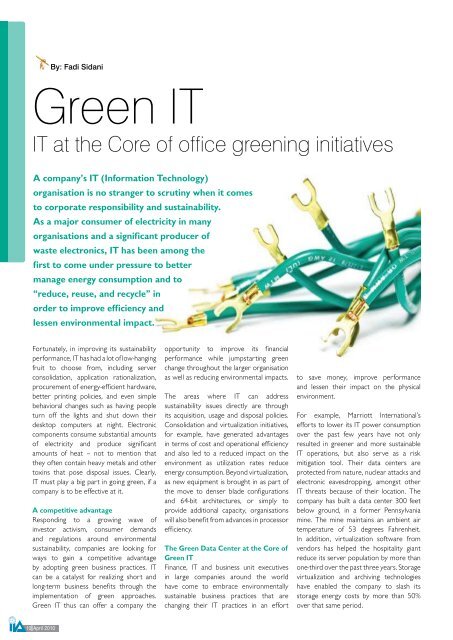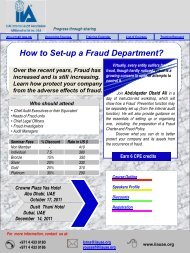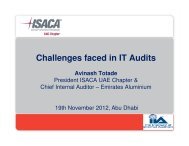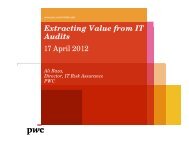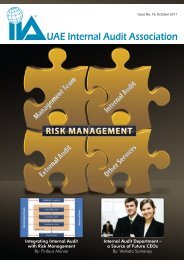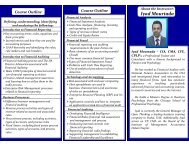IIA April 2010.pdf - UAE IAA
IIA April 2010.pdf - UAE IAA
IIA April 2010.pdf - UAE IAA
Create successful ePaper yourself
Turn your PDF publications into a flip-book with our unique Google optimized e-Paper software.
By: Fadi Sidani<br />
Green IT<br />
IT at the Core of office greening initiatives<br />
A company’s IT (Information Technology)<br />
organisation is no stranger to scrutiny when it comes<br />
to corporate responsibility and sustainability.<br />
As a major consumer of electricity in many<br />
organisations and a significant producer of<br />
waste electronics, IT has been among the<br />
first to come under pressure to better<br />
manage energy consumption and to<br />
“reduce, reuse, and recycle” in<br />
order to improve efficiency and<br />
lessen environmental impact.<br />
Fortunately, in improving its sustainability<br />
performance, IT has had a lot of low-hanging<br />
fruit to choose from, including server<br />
consolidation, application rationalization,<br />
procurement of energy-efficient hardware,<br />
better printing policies, and even simple<br />
behavioral changes such as having people<br />
turn off the lights and shut down their<br />
desktop computers at night. Electronic<br />
components consume substantial amounts<br />
of electricity and produce significant<br />
amounts of heat – not to mention that<br />
they often contain heavy metals and other<br />
toxins that pose disposal issues. Clearly,<br />
IT must play a big part in going green, if a<br />
company is to be effective at it.<br />
A competitive advantage<br />
Responding to a growing wave of<br />
investor activism, consumer demands<br />
and regulations around environmental<br />
sustainability, companies are looking for<br />
ways to gain a competitive advantage<br />
by adopting green business practices. IT<br />
can be a catalyst for realizing short and<br />
long-term business benefits through the<br />
implementation of green approaches.<br />
Green IT thus can offer a company the<br />
opportunity to improve its financial<br />
performance while jumpstarting green<br />
change throughout the larger organisation<br />
as well as reducing environmental impacts.<br />
The areas where IT can address<br />
sustainability issues directly are through<br />
its acquisition, usage and disposal policies.<br />
Consolidation and virtualization initiatives,<br />
for example, have generated advantages<br />
in terms of cost and operational efficiency<br />
and also led to a reduced impact on the<br />
environment as utilization rates reduce<br />
energy consumption. Beyond virtualization,<br />
as new equipment is brought in as part of<br />
the move to denser blade configurations<br />
and 64-bit architectures, or simply to<br />
provide additional capacity, organisations<br />
will also benefit from advances in processor<br />
efficiency.<br />
The Green Data Center at the Core of<br />
Green IT<br />
Finance, IT and business unit executives<br />
in large companies around the world<br />
have come to embrace environmentally<br />
sustainable business practices that are<br />
changing their IT practices in an effort<br />
to save money, improve performance<br />
and lessen their impact on the physical<br />
environment.<br />
For example, Marriott International’s<br />
efforts to lower its IT power consumption<br />
over the past few years have not only<br />
resulted in greener and more sustainable<br />
IT operations, but also serve as a risk<br />
mitigation tool. Their data centers are<br />
protected from nature, nuclear attacks and<br />
electronic eavesdropping, amongst other<br />
IT threats because of their location. The<br />
company has built a data center 300 feet<br />
below ground, in a former Pennsylvania<br />
mine. The mine maintains an ambient air<br />
temperature of 53 degrees Fahrenheit.<br />
In addition, virtualization software from<br />
vendors has helped the hospitality giant<br />
reduce its server population by more than<br />
one-third over the past three years. Storage<br />
virtualization and archiving technologies<br />
have enabled the company to slash its<br />
storage energy costs by more than 50%<br />
over that same period.<br />
Traditionally, data centers have been<br />
designed to store, process, manage and<br />
exchange information in order to either<br />
support the informational needs of large<br />
institutions or provide application services<br />
or management for information technology,<br />
telecommunication, web hosting, internet<br />
or intranet. These data centers have been<br />
designed to accommodate energy intensive<br />
computing equipment and the speciallydesigned<br />
infrastructure for high electrical<br />
power consumption, redundant and<br />
uninterruptible power and heat dissipation.<br />
Based on their energy signatures, large data<br />
centers are actually more like industrial<br />
facilities than commercial buildings. Careful<br />
attention is usually paid to maximizing the<br />
computing power in the traditional data<br />
center, but often very little consideration<br />
is given to environmental issues.<br />
Green data centers are ecologically friendly<br />
data centers where the mechanical,<br />
electrical, thermal, hosted systems and<br />
building materials are all used to improve<br />
energy efficiency and effectively manage<br />
any negative environmental impact. Until<br />
recently, no one seemed to care whether<br />
or not data centers were environmentally<br />
friendly. Now, financial, legislative and<br />
environmental pressures are causing data<br />
centers to take steps toward ‘going green.’<br />
Baby steps<br />
Environmental improvement and<br />
sustainability initiatives can be addressed<br />
and implemented through basic efforts<br />
such as the thoughtful use of technology,<br />
a combination of high-quality financial and<br />
operating information, useful metrics and<br />
well-considered business cases and strong<br />
executive commitment. But there are no<br />
simple answers to building a sustainable<br />
enterprise.<br />
Companies have taken many early steps<br />
in the first wave of green IT to lessen<br />
their environmental impact. For example,<br />
they have retired out-of-date systems,<br />
consolidated data centers like the<br />
aforementioned example and adopted<br />
substantially more efficient hardware and<br />
cooling systems. These early efforts have<br />
been focused on cutting waste, decreasing<br />
energy usage, and optimizing the efficiency<br />
of IT assets in data centers, on desktops,<br />
and throughout company operations.<br />
And executives say these early steps have<br />
yielded returns that are satisfactory or<br />
even better.<br />
Some companies have been particularly<br />
ambitious in leading environmental change,<br />
whether led by a desire to keep pace<br />
with competitors, to avoid penalties or<br />
bad publicity, or simply their own sense<br />
of right and wrong. Those who adopt a<br />
wait-and-see attitude may well be caught<br />
short, pulled under the next wave of<br />
green IT and forced to struggle to catch<br />
up or even survive. Those who are well<br />
prepared, especially those who learned the<br />
importance of strategic investments during<br />
the last economic downturn may well be<br />
able to ride this wave successfully and even<br />
flourish as a result.<br />
Evolve into a sustainable business over<br />
time<br />
Although Green IT efforts have focused in<br />
particular on increasing energy efficiency<br />
in IT infrastructure management, e.g.<br />
‘Green Data Centers’, this focus does<br />
not suffice. Environmental sustainability<br />
needs to go beyond simply improving the<br />
energy efficiency of the IT infrastructure<br />
– and include business solutions that<br />
help customers move towards greater<br />
levels of maturity in their management of<br />
sustainability practices.<br />
‘Smart’ companies address environmental,<br />
economic and social factors – the three<br />
pillars that make a company sustainable.<br />
Namely, IT that contributes to the wellbeing<br />
of society, contributes to preserving<br />
natural resources and ecosystem and IT<br />
that improves economic sustainability.<br />
Companies can take internal steps to<br />
improve processes and cut waste, but the<br />
giant leap forward will come from more<br />
environmentally sensitive solutions coming<br />
to market for them to employ. Such<br />
progress will allow companies to mitigate<br />
risk and strive to be a good corporate<br />
citizen, an employer for which people want<br />
to work, and a company that deserves<br />
customers’ business.<br />
IT as the catalyst for change<br />
IT organisations do not have to tear down<br />
their existing data centers and start from<br />
scratch in order to start benefiting from<br />
environmentally friendly technologies and<br />
processes. IT organisations just need to<br />
start considering these in the data center<br />
planning process. Incorporating green<br />
thinking into plans involves everything<br />
from purchasing energy efficient hardware<br />
made from more environmentally friendly<br />
materials to implementing rationalization<br />
projects to designing new data centers and<br />
locating them in places where they can take<br />
advantage of alternative power or cooling<br />
methods. The sooner data centers start<br />
taking steps toward implementing green<br />
technologies and processes, the sooner<br />
they will start realizing the benefits.<br />
No blueprint or one-size-fits-all master plan<br />
exists. But one thing above all others is clear:<br />
the best results will come to organisations<br />
which include IT as an integral supporting<br />
element of its environmental and broader<br />
sustainability initiatives.<br />
About the Author:<br />
Fadi Sidani is the Partner in charge of Enterprise Risk Services<br />
(ERS) at Deloitte in the Middle East. Fadi has 22 years of global<br />
experience in Risk Management, Consulting and Sustainability<br />
work across various markets, industries and business functions.<br />
He is a regular public speaker in many forums across the ME<br />
region, and he has been involved in the set up and delivery of<br />
various training courses for staff and clients. For more information<br />
please contact + 971 4 369 8999<br />
10 <strong>April</strong> 2010 11 <strong>April</strong> 2010


